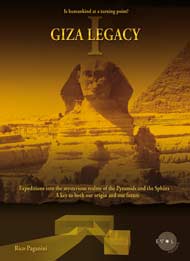The Epilogue by Dr. J.J. Hurtak
Gradually, level by level, the Giza plateau is giving up its secrets. A vast new complex will soon arise from the sands of Giza, providing visitors with the ability to experience the ancient architecture of Egypt in virtual reality. Stand on the sands in the place of the Sound and Light Show and look towards the Sphinx and the great Pyramidal complex behind and every visitor remains in awe. Engineers and Egyptologists are drawn to these incredible structures and the mysteries of Egypt like young people to the cinema screen of Steven Spielbergs latest film creation.
The Wall also has become a provocative edifice, and architects and engineers are forced to tip their hats to its construction. Eyes open as its engineering marvel continues to reach outward more and more into the desert. Prior to 2002, I and my colleagues heard nothing about the construction of the Wall of Egypt until it was brought to my attention by Rico Paganini and Armin Risi. This book is truly an historic record, as well as a textbook for all readers who realize that the monuments of Egypt relate to the scientific quest for life.
The Wall is, in fact, a line in the sand between the older generation of classical Egyptologists and younger minds who are prepared to take a quantum leap and look beneath the sands of Egypt with the possibilities of far-reaching consequences, rewriting the legacy of civilization through new Rosetta stones. Will the underground chambers of Rostau speak and teach of a previous age revealing a vibratory wall and musical artifacts that will set history on its head? In addition to the Osiris Tomb, remote sensing evidence has shown that there are still many more chambers and passageways to be found under the Plateau. Is the Great Pyramid the tip of a vast altar complex of stellar knowledge for human-divine interactions, from ages past?
The treasury of the pyramidal and temple monuments still challenges everything we have learned about the processing of huge blocks of stone, civil engineering and transportation of tons of stone to spectacular heights. Was there a vast organization of labor and project management or were there ancient secrets to the methods of construction that are now lost to our distant past?
Researchers with views that differ from the official Egyptological explanation of the Great Pyramid are usually scoffed at and ridiculed by those who adamantly support the orthodox view. This has always been the case for as long as books have been published on the subject and as long as modern man has asked: Who built the Pyramids? In this new page of history we are influenced by a different group of peers, and therefore, it is their research that will also need to be seriously assessed. Interestingly, the ranks of those who differ with classical Egyptology are now becoming populated by those who wish to share high levels of technical expertise, such as engineers, physicists and architects. What you have just read has now provided you with a major sourcebook of information and there is none other like it. The pictures allow individuals to see the connections first hand. It is important to realize most books on the area of the Great Pyramid contain the theories and viewpoints of thinkers on the surface. This book is objective in that it does not promote any one theory or viewpoint, but presents all the questions of the Wall and pre-history of the monuments from a pluralistic view of ancient writers and the living testimony of the megalithic pieces themselves. Of course, the reader must come to his or her own conclusions using both the eye of the flesh and the minds eye.
My research with remote sensing, the study of the stellar alignments in the King’s Chamber with Orion (which I conducted and published as early as l973), and the acoustical measurement of temple structures throughout the world, helped me to understand how new technology advances our ability to increase our knowledge. But I still must ask: Have we come to the understanding of the next phase of the mythical history or are we about to discover the Stargate itself? Will the last remaining wonders of the world finally come to light or will they remain hidden in time capsules? Will Egypt keep its secrets to itself for time immemorial?
The ancient Egyptian Coptic text of Asclepius found in 1945 tells the reader there is much more to learn about the ancients. In the story, the initiate Asclepius is taught by the teacher Hermes who schools him in the mysteries of Egypt and tells him how glorious Egypt was in its past, as we read: O Asclepius, for if it is proper for us to speak the truth, our land is the temple of the world. [But in the future] no longer will it be full of temples, but it will be full of tombs… And what is this that I say about the Egyptians? For they will not abandon Egypt. It is our hope that we can, again, turn these tombs back into temples of understanding.
Now, the greatest Wall to be opened is that within the minds of men. Let us understand the gifted legacy we have at Giza. Let us never stop exploring and seeking to discover a common ground. Let us build the treasury of future artifacts which bring together the pieces of our higher heritage. In this deeper sense, the face of the Sphinx will live on in our faces and Giza will become a beacon of light to the world.
Dr. J.J. Hurtak, Ph.D., Ph.D
This is an excerpt from the book GIZA LEGACY.

